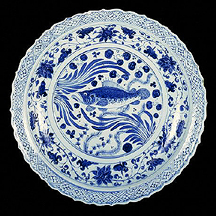
Yuan dynasty, 14th century CE
From Jingdezhen, Jiangxi province
Underglaze blue porcelain
Diameter: 46.5 cm
Height: 7.5 cm
Bequeathed by Mrs. Walter Sedgwick
Acquisition number: #OA 1968.4-22.26
Image courtesy of the British Museum (copyright reserved)
Scholars at the British Museum have completed a very careful study of this porcelain dish. They note that underglaze blue porcelain (often referred to as "blue and white ware") is believed to have been developed in China in the second quarter of the fourteenth century. It was previously believed that most of the ware s of this type was made for export to the Islamic dynasties of Central Asian and Persia. However, it became clear through closer study of Jingdezhen porcelain production sites that at least some of the underglaze blue wares were intended for domestic consumption.1
The shape (particularly in the foliated rim) appears to be inspired by metalwork imported from the Near East, while the decorative motifs are of both Islamic and Chinese origin. The repetitive geometric patterns and flowers-and-vines motif are commonly found on Sassanian silver, and were imported much earlier in China's history. The design of fish swimming among water plants, however, is of Chinese origin.2
(1) See the British Museum web page dedicated to this object.
(2) Ibid.